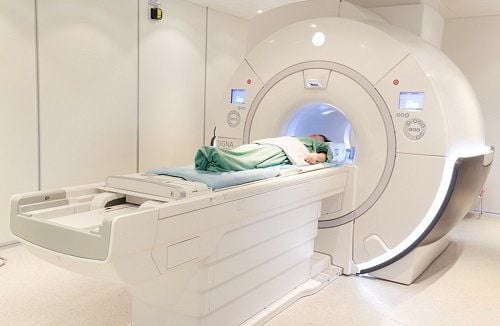This is an automatically translated article.
The article is professionally consulted by Master, Doctor Nguyen Van Phan - Head of Interventional Imaging Unit - Department of Diagnostic Imaging and Nuclear Medicine - Vinmec Times City International General Hospital. Doctor Nguyen Van Phan is an interventional radiologist and radiologist.Digital uterine artery angiography and embolization is a treatment that preserves uterine integrity. This technique uses X-rays and a water-soluble iodinated contrast agent to visualize the uterine arteries.
1. What is digitized uterine artery angiography and embolization?
Digital angiography with background erasure is a combination of conventional angiography techniques by Seldinger technique with image processing techniques by digitizing background erasing factor.Uterine artery embolization is an effective method of preserving uterine integrity. Safe procedure, short hospital stay, patients recover soon after the procedure. This procedure is used to treat uterine leiomyoma, endometrioma, postpartum bleeding, uterine vascular malformation....
1.1 Indications Uterine artery angiography and embolization Background digitization is indicated in cases such as:
Uterine smooth muscle tumor causes clinical signs (abdominal pain, menstrual disorders, compression, abortion....). Endometriosis in the myometrium, postpartum bleeding, uterine vascular malformation... Hemostasis: Cervical cancer, uterine bleeding, uterine artery chemotherapy.... Menorrhagia, heavy bleeding due to other causes (cervical cancer, endometriosis....) failed internal treatment. 1.2 Contraindications Like the general contraindications of angiography, angiography and digital uterine artery embolization are contraindicated in the following cases:
Existing infectious disease; liver failure, kidney failure, severe heart failure; have hemophilia; diabetes ; a history of allergy to preparations containing iodine; have a history of bronchial asthma ... Women who are pregnant, have appendicitis and are suspected of malignancy of the uterus and cervix.

2. Digital uterine artery embolization and embolization procedure
2.1 Preparation of Executor Interventional Radiology Specialist Interventional Radiology Technician Anesthesiologist/technician (if patient is difficult to cooperate); Nursing. Means Digital Eraser Angiography (DSA); Image storage system, film printer, film; Specialized contrast injection machine; The lead skirt, shirt and collar help shield X-rays. Medicines Antiseptic solution for skin and mucous membranes. Local anesthetics General anesthetics (if necessary) Water-soluble iodinated contrast agents; Heparin and Heparin neutralizing drugs; General medical supplies 1, 3, 5, 10ml syringes and syringes for contrast injection machines. Physiological saline; Etroley car. Surgical clothing; Sterile kit (scissors, knife, tongs, tool tray, etc.); Cotton gauze, surgical medical adhesive tape. Special medical supplies Arterial needles; Standard conductor 0.035 inch; Circuit opening set 5F - 6F; Microcatheter 1.9F – 2.7F, microwire 0.014 - 0.018 inch; Angiography Catheter 4F - 5F Y-wire Set Embolization Materials Bio-foam to help stop bleeding; Synthetic resin (PVA); Bio-adhesive (Histoacryl); Metal coils (coils) of all sizes. Patients Patients are carefully explained about the procedure to coordinate with the doctor. Need to fast, drink before 6 hours. Can drink no more than 50ml of water. In the intervention room: the patient lies on his back, fitted with a monitor to monitor breathing, pulse, blood pressure, electrocardiogram, SpO2. Disinfect the skin, then cover with a sterile, perforated cloth. The patient is too excited, cannot lie still, needs sedation... Test card Inpatient medical record There is an approved order to perform the procedure. X-ray, micro-tomography Computed tomography (CT), magnetic resonance imaging (CHT) (if any).
Ultrasound after 3 - 6 - 12 - 24 months Magnetic resonance imaging can be done after 6 months.

3. Accidents and handling
Very few serious adverse events occur. However, some rare cases may occur such as: Bleeding, hematoma at the puncture site, but very rarely. The patient may have pain in the lower abdomen after a few hours of the procedure due to embolism, aseptic necrosis of the tumor. Treat with the use of specialist pain relievers. If you experience any unusual symptoms or complications, you should immediately contact your doctor for timely treatment. Vinmec International General Hospital is a high-quality medical facility in Vietnam with a team of highly qualified medical professionals, well-trained, domestic and foreign, and experienced.A system of modern and advanced medical equipment, possessing many of the best machines in the world, helping to detect many difficult and dangerous diseases in a short time, supporting the diagnosis and treatment of doctors the most effective. The hospital space is designed according to 5-star hotel standards, giving patients comfort, friendliness and peace of mind.
For detailed information, please contact the hospitals and clinics of Vinmec health system nationwide.
Please dial HOTLINE for more information or register for an appointment HERE. Download MyVinmec app to make appointments faster and to manage your bookings easily.
SEE MOREPrinciples of digital background angiography (DSA) Digital erasure of the splenic vein background - portal angiography Process of digitally erasing the background of the visceral system














